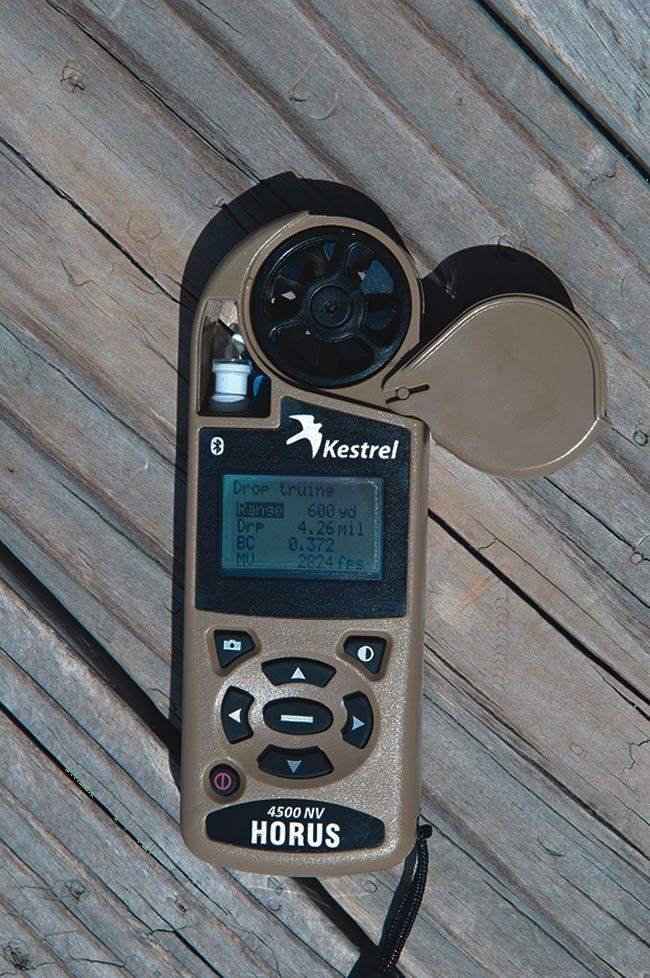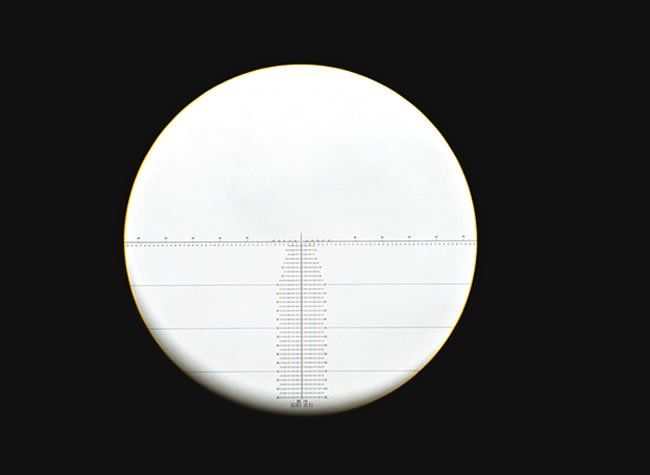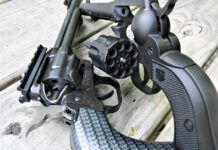Thanks to advancements in military technology, many innovative products are now available to the civilian buyer. We suspect that such products are a couple of generations behind what is actually in the hands of our elite soldiers, but in the case of the Bushnell Tactical Elite XRS riflescope ET45305ZA, with the Horus Vision TRMR2 H-59 reticle, the civilian may indeed have his hands on the cutting edge. The H-59 reticle offers precision mil-marking clusters interspersed throughout the reticle to enable fast accurate measurements at .1, .2, .5 and 1 mil increments, according to Bushnell literature. This enables the operator to quickly range targets and also correct for windage, elevation, and even movement without necessarily having to adjust the respective turrets manually.
In a recent discussion with high-level contractors, one trainer tasked with producing snipers and designated marksmen for the military said, Ive got squads using this very scope running through mock battles right now.
Horus Vision of San Bruno, California developed the Horus family of reticles and offers a similar scope under its own brand name. The Horus Vision HDMR 3.5-21X50 scope with H-59 reticle carries a suggested retail price that is considerably less ($1600), but the Bushnell offering is more robust, as signified by its 12 ounces of additional weight. The Bushnell Elite Tactical XRS Extreme Range Scopes are built to Mil-Spec standards, including a special protective finish on its aluminum body. Our scope featured a Zero stop, or Z-stop, function, which means once the zero is set on the elevation turret, the operator can return to this baseline virtually with his eyes closed. This becomes imperative when elevation adjustments require more than one revolution. Of contemporary long-range rifle scopes built to Mil-Spec standards, the $2200 Bushnell Elite Tactical XRS Extreme Range Scope is probably the least expensive unit, making it, in our view, the most accessible of its kind for the civilian shooter interested in extreme long-range accuracy.

In terms of visual impact, were not sure everyone is prepared for opening the box and finding a 2.9-pound scope built on a 34mm tube. The 50mm objective lens doesnt taper much, and the Flat Dark Earth finish will not blend in with a black rifle. Also, the turrets are tall, in part because they utilize caps that pull away (without detaching) for adjustment. Push them back down, and the new setting is locked. This amount of adjustment is needed because each click changes the setting only one-tenth of a mil (or 10 clicks per 1 Mil). This is an advantage at longer distances when a small change means a lot.
In addition to these exterior cues, theres also a third turret, the parallax adjustment, on the left-hand side. This is used primarily to focus the target. It wasnt marked for yardage because such calibrations are merely guidelines. The shooters eye is the final judge. But it was marked with successive dots of increasing size and offered about 300 degrees of one full rotation. This dial did not lock nor click, but each detent felt positive, and it proved safe from unwanted movement. Focal adjustment of the reticle was achieved at the eyepiece via the diopter adjustment ring, but we cant recall anyone on our staff changing the factory setting throughout our tests. The 4.5-30X magnification ring was stable and easy to use, turning independently of the body. Each time we sighted in, we reset the windage and elevation knobs to display zero by using a coin to unscrew the locking cap, lifting off the knob, and replacing it. The locking caps contained a rubber O-ring to seal it from moisture. The zero-stop feature is controlled by two set screws and a locking ring beneath the elevation cap. We found it quick and easy to set and reset.
We thought finding 34mm rings would be a problem, but there on Brownells.com, we saw about ten different sets. None of them were a color match, but we chose 1.275-inch-high aluminum rings by Badger Ordnance with a 0.5-inch hex nut for tightening (093-000-017AK, $200).
With the shooter behind the scope, the Horus reticle presents what our shooters described as a virtual ruler in the form of a calibrated grid that allows the shooter to adjust much more precisely than visualizing a point of aim hanging in open space. For example, during our sight-ins, we were able to accurately measure how far off our initial shot was by locating the misplaced bullet hole on the reticle while holding the crosshairs on the original point of aim. Then we could dial in these adjustments without looking, and our next hit would be dead on.
The Bushnell Tactical Elite scopes operate with the reticle in the first focal plane. This means the reticle appears larger and smaller depending on magnification. At our scopes lowest power (4.5X), the grid formed by the mil markings came together and formed a spire that pointed to the center. This offered a degree of coarse aim for center-mass hits at nearer targets. At full magnification, the grid is at its widest and most easy to read, but the ranging of targets (determining the distance to a target of known size by measuring its height as it appears against the calibrations of the vertical crosshair) may be performed with magnification adjusted to any power, minimum or maximum. This is why many precision shooters prefer the first focal plane feature.
Ranging, or rifle scope range estimation, is commonly figured by dividing target height in inches multiplied by 27.77 by the height of the target in mils as it appears in the scope. But the Horus H-59 reticle also incorporates Todd Hodnetts Accuracy 1st Speed Shooting Formula, making it possible to rapidly determine elevation hold by making use of the moving target lead lines (yes it figures lead, too) found above the horizontal crosshair, or stadia.
The Accuracy 1st Speed Shooting Formula begins with focusing on a 12-inch-square portion of the target or even a 12-inch object near the target. Place the 12-inch area on the horizontal crosshair and move it into position so that it fits tightly beneath one of the series of broken lines that rise and fall above the crosshair. This is called bracketing. Once bracketed into place, the target area will appear bisected by a vertical line rising from the crosshair with a corresponding numerical value. The amount of elevation change necessary will be half of this value. But the faster way to account for elevation change is to raise the scope so that the target is now centered on the corresponding stadia line below center.

The Horus reticle system was designed to make the user fully independent in the field. But its also a natural for computer applications. Palm Pilot apps are available, but we chose to synchronize our scope with the Kestrel 4500NV Horus ATrag Ballistics Meter, ($590 from KestrelMeters.com).

For tests, we chose two different 223 Remington rifles. We wanted to use a round that was more likely to be deflected by crosswinds so we could better evaluate the extra calibration points displayed in the Horus H-59 reticle. With a maximum range of only 600 yards to play with, we wanted to make sure our range sessions were challenging. Test rifles were a Bushmaster AR-15 with 20-inch barrel and a Kimber Light Police Tactical bolt-action rifle. The Bushmaster was used for our short yardage tests of the adjustment turrets to find out how well we could repeat zero.
The Kimber rifle had recently been rebarreled with a Shilen 1:8-twist barrel by master smith Mike Bryant (Mike@BryantCustom.com, [806] 826-5618). Fully broken in, this rifle allowed us to print 100-yard 5-shot groups measuring about 0.37 inches across on a regular basis, so we knew we had a good test bed for our scope. The AR-15 was loaded with new manufacture Black Hills 60-grain V-Max rounds, and the Kimber LPT rifle was fed its favorite Black Hills remanufactured 77-grain BTHP rounds.
Our first test was to see if the windage knobs could be turned right then left and return to the same point of zero. Test distance was 50 yards. One full turn of windage (10 mil) was available, and our first attempt showed two results. First, return to zero left us a little more than inch shy of return to zero. We also noticed that our groups at the extreme left and right were tighter than our group in the center. We wondered if the mechanism was more stable when locked against its maximum adjustment and was floating when the forces of its locating springs was relatively relaxed. This condition improved with repeat tests, so we think there was an element of break-in as the springs that push and pull were used. Much more elevation adjustment is available than 10 mil (about 29 mil, or 290 total clicks), but we stuck with our 10 mils up, 20 mils down, and 10 mils up to zero procedure. Results showed that the elevation mechanism was spot on. When measuring to find the center of each group above and below our original point of aim, return to zero was within 0.1 inch. With so much capability to hold off left or right, mechanical elevation adjustment is by far the more critical measurement, and the Bushnell scored high in this area, we thought.

Switching the scope to the Kimber LPT, we concluded that the relatively short body of the Bushnell Tactical Elite caused it to be sensitive to eye relief. With a limited amount of space along the 34mm tube to mount the rings, there was little opportunity to shift the scope forward. At 30X power, a full-field view was at times difficult to maintain. For this reason, we would assess that this scope would be easier to mount on an AR-style rifle offering a longer top rail. Long-action bolt-guns might have an easier time of it by providing a longer scope mount, but one of the chassis systems such as Surgeon or Accuracy International would probably be ideal.
With the Kimber LPT sighted in at 100 yards, we decided to consult the Kestrel for come-ups for both 300- and 600-yard shots. Up to 56 rifle and load combinations can be entered, but standard information specifically for the Black Hills 77-grain BTHP rounds and other commonly used military loads such as 308 Win., 308 Win. for the short-barreled rifle or Scout style, 300 Win. Mag., and 338 Lapua were already on file and waiting for relative input. This included temperature, humidity, bore height (the differential between bore line and sight line), ballistic coefficient and velocity. Average wind speed could also be calculated and entered. The Kestrel was capable of reporting calculations in minutes of angle (MOA) or Mil, and we could read the results in one of two ways. First was by scrolling down a range card in 50-yard increments on screen. This included windage adjustments as per our previous input. Elevation adjustment was also displayed as True Bullet Drop. We liked this better because we could scroll through a separate line for actual distance and get an elevation adjustment computed to the 1/100th mil (or 1/100th MOA).
Our 100-yard zero and our shots from the 300-yard line and 600-yard lines were performed on three different days. Each day was different in terms of available light, time of day, wind speed, and direction of the wind. The barrel was not cleaned between sessions to avoid the necessity of a fouling shot. In each case, we consulted the Kestrel for the proper setting, and in each case our shots landed precisely where the Kestrel predicted. (We tried the Kestrel with a comparably priced scope offering a Mil-dot reticle and found that it was just as accurate.)
Our Team Said: The Bushnell Elite Tactical XRS Extreme Range Scope ET45305ZA with Horus H-59 reticle at $2200 is a super-specialized piece of optics. Because of its price, weight, complexity, and in comparison to other scopes in the $2000+ MSRP price range, its light transmission and clarity, we gave it a B+ grade. Also, for the experienced marksman raised on simple crosshairs, one question immediately comes to mind. Is the sight picture too busy? Not everyone can be blessed with intuitive aim, but anyone can learn to use this scope. We were able to keep the grid in perspective and not let it block out what we needed to see downrange. If the reticle had instead been in the second focal plane and not changed with the field of view, we think it might have indeed been distracting. If we were concerned with the extra markings making us lazy in terms of developing hold-off skills, we think it was a teaching tool rather than an impediment.
Written and photographed by Roger Eckstine, using evaluations from Gun Tests team testers. GT




























